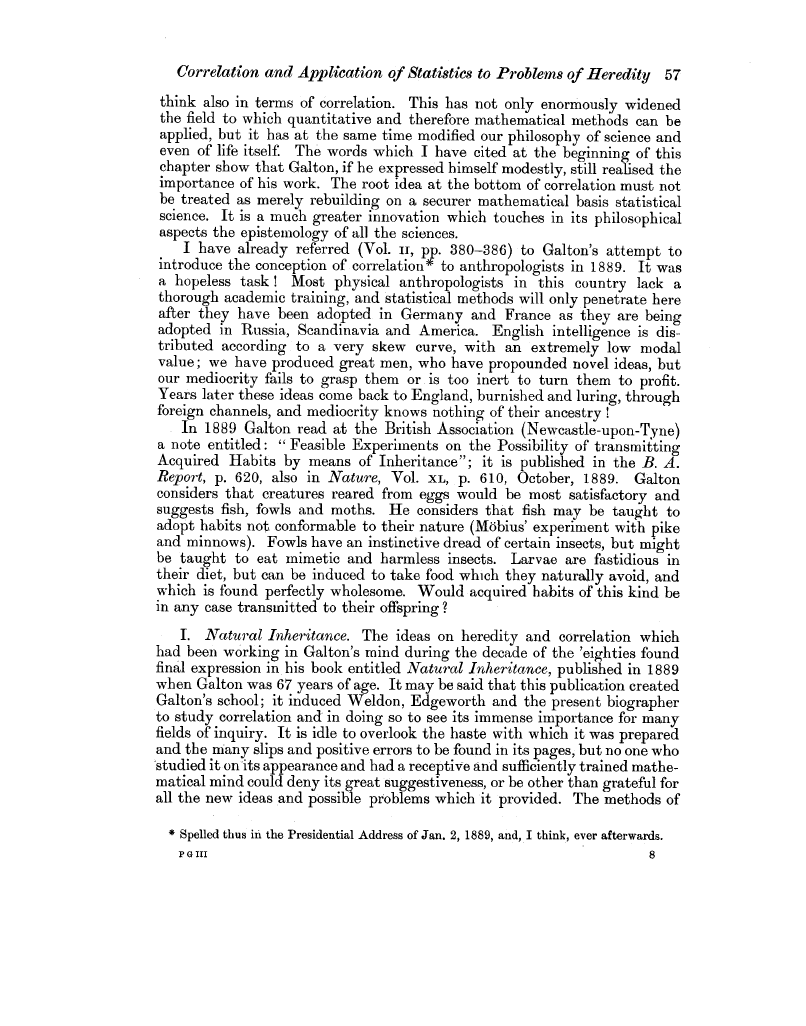| ||||||

OCR Rendition - approximate
Correlation and Application of Statistics to Problems of Heredity 57 think also in terms of correlation. This has not only enormously widened the field to which quantitative and therefore mathematical methods can be applied, but it has at the same time modified our philosophy of science and even of life itself. The words which I have cited at the beginning of this chapter show that Galton, if he expressed himself modestly, still realised the importance of his work. The root idea at the bottom of correlation must not be treated as merely rebuilding on a securer mathematical basis statistical science. It is a much greater innovation which touches in its philosophical aspects the epistemology of all the sciences. I have already referred (Vol. ii, pp. 380-386) to Galton's attempt to introduce the conception of correlation* to anthropologists in 1889. It was a hopeless task ! Most physical anthropologists in this country lack a thorough academic training, and statistical methods will only penetrate here after they have been adopted in Germany and France as they are being adopted in Russia, Scandinavia and America. English intelligence is distributed according to a very skew curve, with an extremely low modal value; we have produced great men, who have propounded novel ideas, but our mediocrity fails to grasp them or is too inert to turn them to profit. Years later these ideas come back to England, burnished and luring, through foreign channels, and mediocrity knows nothing of their ancestry ! In 1889 Galton read at the British Association (Newcastle-upon-Tyne) a note entitled : " Feasible Experiments on the Possibility of transmitting Acquired Habits by means of Inheritance"; it is published in the B. A. Report, p. 620, also in Nature, Vol. XL, p. 610, October, 1889. Galton considers that creatures reared from eggs would be most satisfactory and suggests fish, fowls and moths. He considers that fish may be taught to adopt habits not conformable to their nature (MObius' experiment with pike and minnows). Fowls have an instinctive dread of certain insects, but might be taught to eat mimetic and harmless insects. Larvae are fastidious in their diet, but can be induced to take food which they naturally avoid, and which is found perfectly wholesome. Would acquired habits of this kind be in any case transmitted to their offspring? I. Natural Inheritance. The ideas on heredity and correlation which had been working in Galton's mind during the decade of the 'eighties found final expression in his book entitled Natural Inheritance, published in 1889 when Galton was 67 years of age. It may be said that this publication created Galton's school; it induced Weldon, Edgeworth and the present biographer to study correlation and in doing so to see its immense importance for many fields of inquiry. It is idle to overlook the haste with which it was prepared and the many slips and positive errors to be found in its pages, but no one who studied it on-its appearance and had a receptive and sufficiently trained mathematical mind could deny its great suggestiveness, or be other than grateful for all the new ideas and possible problems which it provided. The methods of Spelled thus in the Presidential Address of Jan. 2, 1889, and, I think, ever afterwards. P G III 8
|